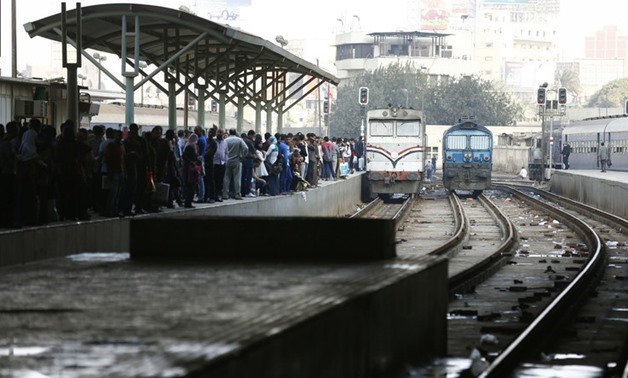
Passengers wait for their train near a damaged train carriage after a bomb exploded at Ramsis railway station in downtown Cairo November 20, 2014. (File photo: Reuters)
CAIRO – 16 October 2024: Egypt's railway system is set to undergo significant development, targeting the transportation of 2 million passengers daily by 2030. This ambitious plan involves expanding the train fleet and extending railway lines. Currently, the railway transports 1 million passengers daily, and the goal is to increase this number by modernizing the infrastructure. Additionally, Egypt’s rail freight transport is expected to rise to 13 million tons annually by 2030, up from 8 million tons in 2024.
1. Train Fleet Modernization: Egypt's railway development plan focuses on upgrading locomotives and carriages. The system recently received 210 new GE locomotives and refurbished 97 out of 220 locomotives. Additionally, 977 out of 1,350 new passenger cars have been delivered, along with six luxury Talgo trains. More than 1,350 passenger cars have been renovated, with further improvements underway for older fleets like the Spanish-manufactured trains.
2. Freight and Sleeper Trains: The freight system saw the delivery of 582 new cargo wagons out of a planned 1,215, while 5,000 freight wagons have been refurbished. Egypt has also invested in luxury sleeper trains, contracting seven new sleeper trains and upgrading its existing fleet of 121 sleeper cars to provide high-end travel services for tourism and local passengers.
New Railway Stations and Lines: Egypt is significantly upgrading its railway infrastructure, including building new stations and expanding existing lines. One notable project is the construction of Said Misr Station in Bashaer, which spans four times the size of Ramses Station in Cairo.
This new station will serve as the final stop for Upper Egypt trains, easing congestion at Ramses Station. It will feature advanced facilities, including 11 platforms and links to major highways such as the Ring Road, the 26th of July Corridor, and the Monorail.
Kafr Dawood-Sadat Line: One of the most significant projects in recent years is the construction of the Kafr Dawood-Sadat railway line, Egypt's first new line in 30 years. Spanning 38 kilometers, this line includes four stations—three serving local villages and Sadat City, and one freight terminal to support the industrial zone in Sadat City and its dry port.
Sinai Rail Projects: The Fardan-Bir Al-Abd railway line in Sinai is a critical part of Egypt’s strategy to develop its logistics network. This line, first constructed in 1916 and damaged multiple times, has been fully restored and is now part of a 355-kilometer extension linking Bir Al-Abd, Arish, and Taba.
The project also includes the construction of a dual bridge over the Suez Canal and improved connectivity to East Port Said.
Egypt's railway network is transitioning from mechanical to electronic signaling systems to enhance safety, increase the number of trains, and reduce travel times.
The Beni Suef-Asyut line is a prime example, where a central control center and multiple signal towers have been installed. In total, Egypt is modernizing signaling systems across 2,000 kilometers of its main railway lines, with significant progress already made on the Cairo-Alexandria and Cairo-Aswan routes.
The ambitious development plan for Egypt's railway system underscores its commitment to enhancing passenger and freight capacity while ensuring safety, efficiency, and connectivity across the country. By 2030, Egypt's railway aims to significantly improve transport services, reducing congestion and contributing to the nation’s overall economic growth.
Comments
Leave a Comment